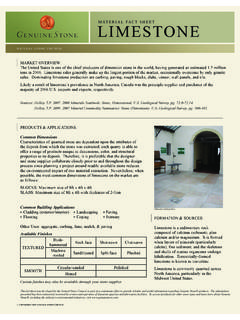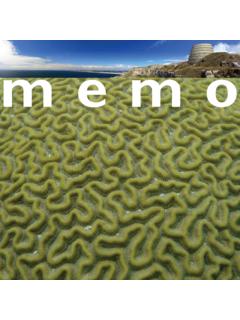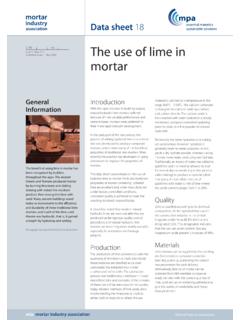Transcription of Limestone Quarrying and Processing ... - Natural …
1 Limestone Quarrying and Processing : A Life-Cycle Inventory A Report Prepared for: The Natural Stone council Prepared by: University of Tennessee Center for Clean Products October 2008 Copyright 2008 Natural Stone council ii Table of Contents 1 INTRODUCTION 1 2 Limestone Quarrying AND Processing OPERATIONS 2 Limestone 2 Limestone Quarrying OPERATIONS 2 Limestone Processing OPERATIONS 3 3 LCI METHODOLOGY 5 LCI DATA COLLECTION 5 QUALITY OF LCI DATA SET 5 Limestone QUARRY OPERATIONS 5 Limestone Processing OPERATIONS 6 4 LCI RESULTS 7 REFERENCES 25 iiiList of Figures FIGURE 1. PROCESS FLOW DIAGRAM FOR Limestone Quarrying FIGURE 2. PROCESS FLOW DIAGRAM FOR Limestone Processing OPERATIONS.
2 3 List of Tables TABLE 1. GROSS ENERGY TO PRODUCE ONE TON OF Limestone TABLE 2. WATER CONSUMPTION FOR Limestone Quarrying AND TABLE 3. LCI INPUTS FOR Limestone Quarrying AND TABLE 4. LCI OUTPUTS FOR Limestone Quarrying AND Processing ..14 TABLE 5. OTHER ANCILLARY INPUTS FOR Limestone Quarrying AND Processing ..23 TABLE 6. OTHER ANCILLARY OUTPUTS FOR Limestone Quarrying AND Processing ..24 11 Introduction The Natural Stone council (NSC) is a collaboration of businesses and trade associations that have come together to promote the use of Genuine Stone in commercial and residential applications. By pooling resources, their goal is to increase the understanding of, preference for, and consumption of these Natural products.
3 Trade associations affiliated with the NSC include Allied Stone Industries, Building Stone Institute, Elberton Granite Association, Indiana Limestone Institute, Marble Institute of America, National Building Granite Quarries Association, and the National Slate Association. Recognizing that green building was becoming a permanent element of the marketplace, the NSC established a Sustainability Committee made up of key industry members to elevate the issue of sustainability within the industry and provide a body responsible for planning and implementing relevant initiatives. In 2007, the NSC Sustainability Committee engaged in a partnership with the Center for Clean Products (CCP) at the University of Tennessee to assess current industry operations relating to dimensional stone production.
4 Prior to this evaluation, the environmental implications of stone extraction and fabrication processes had received little attention compared to other industries. In particular, life-cycle inventory (LCI) data on Natural stone products was limited, not well documented, and out-of-date. This information gap was partially due to the size and varying scale of industry members, the vast diversity of products and materials produced, and the global distribution of stone Quarrying activities. As such, this work presents the most comprehensive survey to-date of the Natural stone industry s practices. Provided in the following text are the results of the first phase of a three-year project launched by the NSC to benchmark and improve the environmental profile of the Natural stone industry.
5 Specifically, the information that follows is an initial LCI characterizing Limestone extraction and production operations in North America. These data will serve as a baseline from which industry best practices can be identified, comparisons to competing products can be made with regard to environmental considerations, and future research can be prioritized. 22 Limestone Quarrying and Processing Operations Limestone Limestone is a sedimentary rock composed primarily of calcium carbonate with the occasional presence of magnesium. Most Limestone is biochemical in origin meaning the calcium carbonate in the stone originated from shelled oceanic creatures. Limestone can also be chemical in origin as is the case with travertine.
6 Chemical Limestone forms when calcium and carbonate ions suspended in water chemically bond and precipitate from their aquatic sources. Because of its high calcium content, Limestone is usually light in color, although many variations exist. Commercially, the term Limestone includes dolomite, dolomitic Limestone , oolitic Limestone , and travertine (Dolley 2007), a porous calcitic rock that is commonly formed near hot springs. The leading stone produced in the US, Limestone accounts for 42% of total domestic production. It is quarried in nine states with Wisconsin and Indiana producing over 87% of US tonnage. Limestone is most commonly employed as rough block for building and construction. Additionally, it is used as dressed stone in various applications including curbing, paneling, veneer, and tile (Dolley 2007).
7 Two general phases of Limestone production exist: Quarrying and Processing . Each of these phases is described below. Limestone Quarrying Operations Extraction (more commonly referred to as Quarrying ) consists of removing blocks or pieces of stone from an identified and unearthed geologic deposit. Differences in the particular Quarrying techniques used often stems from variations in the physical properties of the deposit itself such as density, fracturing/bedding planes, and depth financial considerations, and the site owner s preference. Nevertheless, the process is relatively simple: locate or create (minimal) breaks in the stone, remove the stone using heavy machinery, secure the stone on a vehicle for transport, and move the material to storage.
8 A flow diagram of typical Quarrying operations is shown in Figure 1. Overburden RemovalExtractionTransportation to StorageTransportation to & Storage at On-site LocationScrap StoneScrap StoneQuarry BackfillingTransportation to & Crushing at Crushing Facility Figure 1. Process flow diagram for Limestone Quarrying operations. 3As shown in Figure 1, the first step in Quarrying is to gain access to the Limestone deposit. This is achieved by removing the layer of earth, vegetation, and rock unsuitable for product collectively referred to as overburden with heavy equipment that is sometimes coupled with small explosive charges. The overburden is then transferred to onsite storage for potential use in later reclamation of the site.
9 After the face of the Limestone is exposed, the stone is removed from the quarry in benches, usually 8 to 12 feet square extending 20 feet or more using a variety of techniques suitable to the geology and characteristics of the Limestone deposit. Quarrying operations typically include drilling holes along the perimeter of the bench followed by cutting the stone out of the deposit using saws equipped with diamond wire, or by splitting the stone using hydraulic splitters. If bedding planes are visible, forklifts can be used to pry up the blocks. Once the bench is cut or split loose from the deposit, heavy equipment is used to lift the Limestone bench and transfer it to an inspection area for grading, temporary storage, occasional preprocessing into slabs, and eventual shipment from the site.
10 Limestone of insufficient quality or size for current demand is stored on-site for future use, crushed for use in paving and construction applications, or stored for future site reclamation activities. Limestone Processing Operations Processing operations include much more variation than extraction. Nevertheless, the general procedures begin with initial cutting, followed by application of a finish, and conclude with a second cutting or shaping step. Due to the array of stone products, the second and/or third steps may be eliminated, specifically when the product will have a Natural appearance. Figure 2 depicts the fabrication process. Figure 2. Process flow diagram for Limestone Processing operations.





